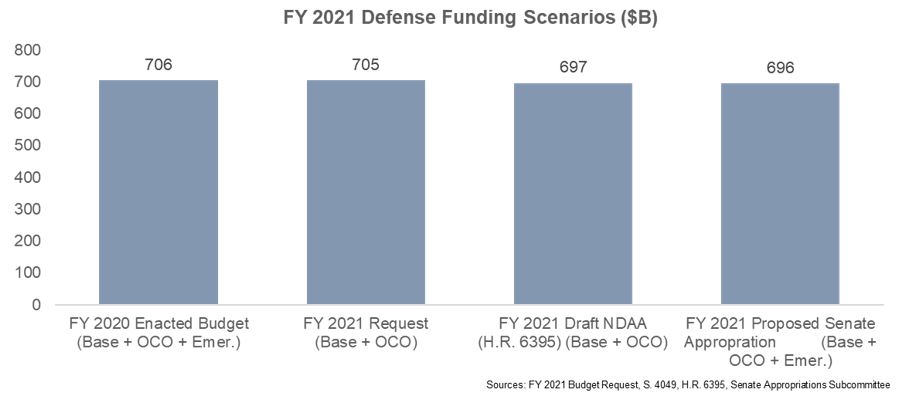FY 2021 Department of Defense Budget Scenarios
Published: November 18, 2020
Federal Market AnalysisBudgetDEFENSENational Defense Authorization ActPolicy and Legislation
The outlook for the DOD’s FY 2021 budget.
Key Takeaways
- The final Department of Defense budget for FY 2021 is likely to be between $695B and $700B.
- The passage of an omnibus funding bill by Congress that includes defense funding for FY 2021 is possible.
- Two hurdles to reaching a budget agreement exist – Congress reaching a funding agreement and the president accepting that agreement.
- Legal challenges to the election results may distract the White House long enough that it decides not to fight for a higher defense appropriation for FY 2021.
Defense budgetary confusion reigns. In addition to dealing with significant leadership changes at the department and uncertainty surrounding the presidential election, the Department of Defense (DOD) is also facing ambiguity as far as its annual budget is concerned. The DOD, like the rest of the federal government, is currently operating under a Continuing Resolution until December 11, 2020, a situation that limits the DOD to previous fiscal year funding levels. New program starts are also forbidden under CRs, although programs already in motion have the authority to continue spending until the CR expires or until another CR is put into place.
Given the current political climate, there is no guarantee that the sharply-divided Congress will be able to pass full year appropriations for FY 2021 or that President Trump will sign any budget legislation sent to him if he does not like it. Either of these potential roadblocks mean the federal government, and industry partners who support it, may be in for another full year CR.
What happens next is anyone’s guess, but here are a few observations suggesting some potential directions/outcomes.
Funding Scenarios
The chart below illustrates the various top-line DOD budget scenarios that are on the table.
Despite the uncertainty surrounding FY 2021 funding, we can say with some confidence that the final defense budget Congress agrees upon will end up somewhere in the neighborhood of $700B, including base discretionary and Overseas Contingency Operating (OCO) funding. Should a full year CR remain in place the DOD would, ironically, receive higher funding (i.e., FY 2020 level) than if the House and Senate agree to a budget closer to the $696B recently proposed by the Senate Defense Appropriations Subcommittee.
The Senate proposal is interesting because it almost matches the total budget authorized in the recently reconciled FY 2021 National Defense Authorization Act (H.R. 6395). The closeness of the appropriation bill total and authorized amount in the NDAA could signal that the Senate is willing to play ball with the House when it comes to the final FY 2021 defense budget. If this is the case, it means that the FY 2021 defense budget will come in just shy of $700B. Should this occur, the DOD’s FY 2021 appropriation could be as much as $10B lower than both the president’s request and the FY 2020 enacted budget.
President Trump then becomes the wild card in the deck. The closer to December we get the more probable it becomes that the White House will be focused on various legal challenges it is mounting to the election results in a number of battleground states. The question becomes at that point if the president has the stomach for a budget fight with Congress at the same time he is fighting for a second term.
Two big questions, therefore, surround the current appropriations situation. The first is if Republicans and Democrats in the two chambers of Congress can agree on a DOD appropriation for FY 2021. If not, we are probably in for a full-year CR. However, given how close the recent Senate GOP budget proposal is to the amount authorized by the House in H.R. 6395, the parties are probably going to agree on a figure around $696-697B. Should this happen, it will be the president’s decision to fight for more funding or to simply approve the appropriation and hope he has a second term to continue the fight for more funding in the future.
Venturing a guess here, the most likely outcome is an omnibus funding package similar to those we’ve had in recent years that funds the DOD to the tune of $696B. President Trump then signs this legislation, meaning defense program officials and industry partners will need to brace for cuts to some programs as the DOD receives roughly $9B less than it did in FY 2020.
